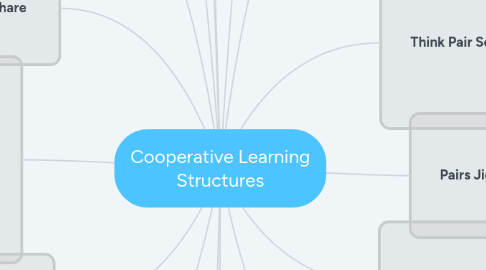Cooperative Learning Structures
by Marlee Hamann


1. Heads Together
1.1. Students are divided in teams. Teacher shows them a picture or asks a question. Students discuss the answer in their teams. Teacher stops the conversation and picks 1 student from a team to answer.
1.2. Teacher prepares questions or problems before class. Students number off. Teacher asks a question. Each student writes down their own answer. They then discuss the answer and sit down either when everyone knows the answer or someone has something to share. Teacher calls a number and students with that number answer simultaneously. Classmates applaud those who have answered.
2. Mix-Pair-Share
2.1. Teacher prepares questions to ask students who start by mixing around the room. Teacher calls "pair". Students pair up with the person closest to them and give a high five. Students who haven't found a partner raise their hands to find each other. Teacher asks one of the prepared questions and gives students think time. Students share with their partners using Timed Pair Share or RallyRobin
3. 3-Step-Interview
3.1. Teacher provides interview topic, states the duration of the interview, and provides think time. In pairs, student A interviews student B. Partners then switch roles. Pairs pair up to form groups of 4. Each student shares with the team what they learned in the interview (RoundRobin)
4. Think-Pair-Share
4.1. Teachers prepare questions based on material. Teacher asks the question to the class and gives the students time to think. Students, in pairs, share their answer and come to a consensus.
5. Inside Outside Circle
5.1. Students make two circles with equal amounts of students in each. One circle should be inside the other with one student from each pair in circle facing each other. The inside students ask their outside partner a question from the question card. The inside students praise and coach the outside's answer. Then, the outside student does the same. Then, partners switch question cards. Finally, inside students rotate clockwise to a new partner (can specify a rotation number)
6. Within-team Jigsaw
6.1. Each student in the team is given a different text/poem to read an analyze. They use RoundRobin to share what they have learned. Can also be done with worksheets.
7. Classic Jigsaw
7.1. Students are places in 'expert teams' to complete an assignment or go over material. Each expert team is given a different topic. After students are finished, they go back to their base teams to share what they learned.
8. Talking Chips
8.1. The teacher provides a discussion topic and talk time. Each time a student contributes to the discussion, they place one talking chip into the center of the table. This continues until all students have placed all of their chips into the middle. They can then pick up their chips and start over.
9. RoundRobin and RallyRobin
9.1. RoundRobin: Teacher asks an open ended question and allows students time to think about it. Students then take turns sharing their thoughts/responses/solutions with their teams
9.2. RallyRobin: same as RoundRobin, but in pairs
10. RoundTable and RallyTable
10.1. RoundTable: Teacher provides a task where there are multiple responses, and provides students time to think. Students each add one answer or contribution before passing the paper and pencil/team project to the next person in their group
10.2. RallyTable: same as RoundTable, but in pairs
11. FInd Someone Who
11.1. Teacher prepares a worksheet/questions for students. students mix in the class, keeping a hand raised until they find a partner that is not a teammate. (In pairs) Student A asks a question from the worksheet. Student B responds and student A records the answer on their own worksheet. Partner B checks and initials answer. Partner B asks a question and repeats the process. Partners shake hands and search for a new partner, keeping their hand raised until they find a new partner. They continue this process until their worksheet is full, in which case they sit down. Students compare answers in teams (if there is disagreement, they raise their hands and ask a group question)
12. Think Pair Square Share
12.1. Teacher asks students and question and students given time to think about their answer. Students pair up and share their answer. They come up with the best answer and the reasoning behind it. They then share their answers and reasoning in a group of 3-4. This answer has to be shared with the whole class. Then, they feedback their group choices giving the reasons behind their choice to the entire class.
12.1.1. Think Square Share: same as Think Pair Square Share but students get in groups of 4
12.1.2. Timed Pair Share: same as Think Pair Square Share, but students share with a partner for a predetermined amount of time
